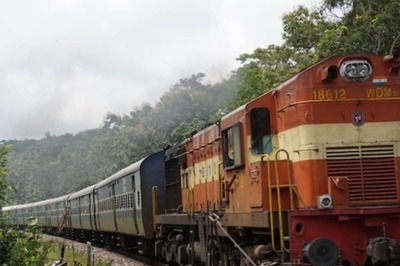
views
Sriharikota (Andhra Pradesh): India on Monday successfully launched its second lunar mission, Chandrayaan-2, onboard its powerful rocket GSLV-MkIII-M1 from the spaceport here to explore the unchartered south pole of the celestial body by landing a rover.
Chandrayaan-2 -- or Moon Chariot 2 -- took off on time at 2:43 pm from the Satish Dhawan Space Centre on an island off the coast of Andhra Pradesh.
Applause broke out in the mission control room as the rocket blasted off into the grey skies over the Indian Ocean and mission control announced that the orbiter had broken away from the rocket with no problem.
"Today is a historic day for space, science and tech in India," Indian Space Research Organisation (ISRO) chief K Sivan said.
The launch came a week after a fuel leak forced a previous attempt to be scrubbed 56 minutes before the scheduled blast-off.
The spacecraft is scheduled to land on the lunar south pole in September and send a rover to explore water deposits that were confirmed by a previous mission that orbited the Moon.
India's first Moon mission orbited the Moon in 2008 and helped confirm the presence of water. The country plans to send its first manned spaceflight by 2022.
Prime Minister Narendra Modi said India's lunar program will get a substantial boost, writing on Twitter that the country's existing knowledge of the Moon "will be significantly enhanced."
The spacecraft is carrying an orbiter, a lander and a rover that will move around on the lunar surface for 14 earth days. It will take around 47 days to travel before landing on the Moon.
India put a satellite into orbit around Mars in the nation's first interplanetary mission in 2013 and 2014. It’s now bidding to follow Russia, the United States and China in landing a spacecraft on the Moon.
The rocket carried an orbiter, a lander and a rover, and has been almost entirely designed and made in India.
The 2.4-tonne (5,300-pound) orbiter is expected to circle the Moon for about a year, taking images of the surface, looking for signs of water, and studying the atmosphere.
The lander -- named after Vikram A. Sarabhai, the father of India's space programme -- will carry the rover and be placed on the surface near the lunar South Pole.
ISRO scientists will remotely control the rover named Pragyaan -- "wisdom" in Sanskrit -- as it carries out experiments. It will work for one lunar day, the equivalent of 14 Earth days, studying rocks and soil on the Moon's surface.
Former NASA scientist Kumar Krishen said India's space agency should be praised for taking on ambitious projects such Chandrayaan-2.
"We should keep in mind that space exploration is risky as many systems have failed in the past and many lives lost," he told AFP.
Aside from propelling India into the rarefied company of spacefaring nations, Chandrayaan-2 also stands out because of its low cost.
About $140 million has been spent on preparations for the mission, a much smaller price tag compared with similar missions by other countries.
The United States -- which is marking the 50th anniversary of Neil Armstrong becoming the first human on the Moon -- spent the equivalent of more than $100 billion on its Apollo missions.
Chandrayaan-2, and India's space programme as a whole, are a source of national pride. Prime Minister Narendra Modi has vowed to send a manned mission into orbit by 2022, and India also hopes to seek out lucrative commercial satellite and orbiting deals.


















Comments
0 comment